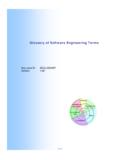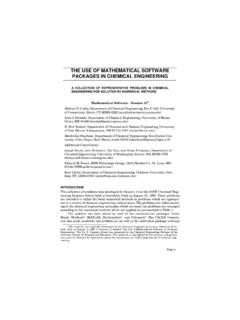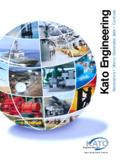Transcription of Product Line Engineering Solutions for Systems …
1 Product line Engineering Solutions for Systems and SoftwareEngineer your Product line portfolio as a single production system rather than a multitude of products223 For businesses to be competitive, today s Product development organizations must deliver a Product line a portfolio of similar products or Systems with variations in features and functions rather than just an individual and software Product line Engineering is an innovative approach that enables organizations to develop, deliver and evolve an entire Product line portfolio, through each stage of the development lifecycle, with much higher degrees of efficiency than have been possible if the innovation, economy of scale, competitive advantage and profitability of your Product line were limited only by your imagination, instead of the capacity of your Engineering team? 34 The characteristic that distinguishes the Systems and software Product line Engineering (PLE) approach from previous efforts is when an organization invests in a means of production that enables it to efficiently create a Product line of similar Systems from a consolidated set of soft assets such as requirements, designs, source code and test cases.
2 Manufacturers of hard goods have long employed analogous Engineering methods to create a Product line of similar Systems using a common factory that assembles and configures parts from a supply chain designed to be shared across the Product software provides the industry s leading PLE solution, offering your organization the infrastructure, tools, best practices and methods needed to create an advanced and efficient means of production for your Product line . Companies that invest in a more efficient means of production for Product line Engineering and delivery can experience a discontinuous jump in produc-tivity, quality, time to market and Product line BigLever PLE solution opens new frontiers in inno-vation, economy of scale, competitive advantage and profitability, impacting the fundamentals of how you compete with your Product lines and profitabilityIn the world of hard goods, a Product line refers to the variations on a common theme, where multiple similar products are combined into one line that offers different sizes, colors, features and functions, with a common goal of filling customer need for a particular kind of item.
3 Econ-omy of scale is a key aspect of the Product line concept, where greater profitability is achieved by investing in an efficient means of production that can be used to deploy different flavors of a Product differentiation and innovation expands from simple physical attributes to complex Systems and software features such as automotive cruise control that adapts to ambient traffic conditions, ships that can shoot down an errant satellite, wind turbines optimized for different environments and mobile phones that guide you back to where you parked your car economy of scale and profitability become dependent on an efficient means of production for different flavors of products and the soft assets from which they are engineered, such as requirements, designs, source code and test development organizations today, virtually all Systems and software Engineering is performed in the context of a Product line .
4 Nobody builds just one. Systems and soft-Figure 1: An efficient means of production for Systems and software Product lines5ware Product lines can be found in every industry across the spectrum, including aerospace, defense, automo-tive, medical, consumer electronics, computer Systems , alternative energy, telecommunications, semiconduc-tor fabrication, software applications, computer games, e-commerce and industrial automation Systems . Sys-tems and software Product lines can be found in every business model, including retail products, government contractors, original equipment manufacturers (OEMs), business-to-business, value-added resellers and custom Product businesses everywhere strive to gain competitive advantage and achieve greater profitability, the need for an efficient means of production for Systems and soft-ware Product lines has become thinking impedes portfolio productionThroughout the first five decades of the Systems and software Engineering field, the methods and tools of the trade have predominantly promoted a Product -centric perspective.
5 The state of the industry today is a bevy of sophisticated Product -centric development tools and processes that can be effectively applied to the development lifecycle of an individual Product from early inception through design, implementation, testing, deployment and , these Product -centric tools do not indepen-dently or collectively offer an effective means to engineer and deliver a Product line . With Product -centric tools, it is left as an exercise for tool users to craft the homegrown techniques for managing the commonalities and vari-abilities among products during the development of their Product line repercussions of taking a Product -centric perspec-tive in a Product line setting are shown in Figure 2. The vertical gold bars highlight the Product -centric focus on the development lifecycle of the individual products (A, B through N) in a Product line . The red lines illustrate the complex, tangled and labor-intensive interactions, dependencies and coordination activities required to take advantage of what is common and to manage all the variations among the similar products as the Product line portfolio evolves over crux of the problem in Figure 2 is that the number of red interdependency lines grows by the square of the number of products in the Product line , explaining why complexity and effort increase exponentially faster than the growth of the Product line .
6 Making matters worse, the conventional Product -centric traceability relation-ships between the different stages of the lifecycle for an individual Product interact with the red Product interde-pendency relationships, multiplying the complexity and introducing dissonance across the stages of the 2: Complex interdependencies resulting from the Product -centric NProduct BProduct AArchitectsDevelopersRequirementsEnginee rsRequirementsEngineersArchitectsDevelop ersQualityAssuranceRequirementsEngineers ArchitectsDevelopersQualityAssuranceQual ityAssuranceDesignModelsTest CasesDesignModelsDesignModelsTest CasesSource CodeSource CodeTest CasesSource CodeRequirementsRequirementsRequirements 6 These tactical development challenges are so large that they impede a company s ability to achieve strategic busi-ness objectives, such as hitting marketplace windows, offering competitive pricing while maximizing profitability, meeting Product quality demands, and expanding the scale and scope of the organization s portfolio.
7 Com-paring the ad hoc, complex and labor-intensive nature of the Product -centric perspective to the sophisticated means of production found in semiconductor fabrication or in automotive manufacturing makes clear that there is an extraordinary need and opportunity for dramatic improvements in Systems and software Product line engi-neering and shift in perspective to an efficient means of productionOrganizations mired in the complexity, inefficiency and pain of Product line Engineering from a Product -centric perspective experience a PLE epiphany when a shift in perspective reveals a simpler solution to the problem. Analogous to Engineering a Product line of hard goods, it is much more effective to view Systems and software Product line Engineering as creating a means of produc-tion a single system capable of automatically producing all of the products in a Product line rather than viewing it as creating a multitude of interrelated products.
8 The pow-erful, though subtle, essence of the PLE epiphany is the focus on that singular means of production rather than a focus on the multitude of 3 shows the single production line perspective for producing the same Product line as in Figure 2, where now the focus is on the means of production inside the red box. The same products, A through N (on the right side of the diagram), are automatically produced by a singular means of production composed of: Feature profiles (top) that describe optional and vari-able features for the products in the Product line , where each Product in the Product line is uniquely defined by its own feature profile. Shared PLE assets (left) such as requirements, archi-tectures, designs, models, source code components, test cases and documentation that can be configured and composed in different ways to create all instances of soft assets and products in a Product line .
9 Variation points shown within these PLE assets support feature-based variation management. Product configurator (center) that automatically com-poses and configures products from the shared PLE assets, using the feature profiles to determine which shared assets to use and how to configure variation points within the assets. We can t solve problems by using the same thinking we used to create them. Albert Einstein7As highlighted by the gold bars in Figures 2 and 3, tilting your head 90 degrees provides the critical shift in per-spective, from the vertical Product -centric focus of Figure 2 to the horizontal PLE production line focus in Figure shifting perspective to focus on the singular means of production rather than the multitude of products, the products are relegated from the primary focus to a consequential corollary of the automated means of production. The exponential complexity of manually managing Product interdependencies is eliminated and replaced by automated production, resulting in dramatic increases in the number of products that can be effec-tively created, deployed and the PLE production line perspective, the scale of a Product line and the scope of diversity within the Product line can be based on business opportunities and profit-ability rather than the complexity limitations imposed by the Product -centric BigLever Gears PLE Lifecycle Framework and PLE MethodologyBigLever software s proven and pragmatic PLE solution, BigLever software Gears , enables you to take the single production line perspective and create an automated, opti-mally efficient means of production for your Systems and software Product lines.
10 With BigLever s industry-standard Gears PLE Lifecycle Framework and 3-Tiered PLE Meth-odology , you have all the essential elements you need, out of the box, to make a discontinuous jump in capability from Product -centric approaches into the new frontier of PLE innovation, efficiency and provides the software infrastructure, tools, inte-grations, methodology, best practices and expertise to guide you through a systematic and incremental transi-tion to an operational Gears production line , precisely as illustrated in Figure 3. By focusing both your business and Engineering teams on the operation of your production line , your organization can plan, develop, deploy and evolve your Product line portfolio, seamlessly and efficiently, Figure 3: Simple and efficient means of production resulting from the PLE production line PLE AssetsProduct AProduct BProduct NRequirementsEngineersProduct LineManagementFeatureProfilesRequirement sDesign ModelsSource CodeTest CasesRequirementsTestCasesDesignModelsSo urceCodeRequirementsTestCasesDesignModel sSourceCodeRequirementsTestCasesDesignMo delsSourceCodeArchitectsDevelopersQualit yAssuranceKeyVariation PointsProfileA8across every stage of your development and delivery life-cycle from business case and analysis, to requirements, design, implementation, testing, delivery, maintenance and award-winning Gears PLE Lifecycle Framework provides a set of industry-standard PLE concepts and constructs that augment your tools, assets and processes across the entire lifecycle.





